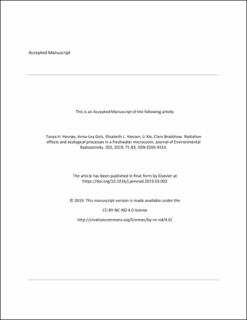| dc.contributor.author | Hevrøy, Tanya H | |
| dc.contributor.author | Golz, Anna-Lea | |
| dc.contributor.author | Hansen, Elisabeth L | |
| dc.contributor.author | Xie, Li | |
| dc.contributor.author | Bradshaw, Clare | |
| dc.date.accessioned | 2020-06-29T12:27:36Z | |
| dc.date.available | 2020-06-29T12:27:36Z | |
| dc.date.created | 2019-06-14T13:38:23Z | |
| dc.date.issued | 2019 | |
| dc.identifier.citation | Journal of Environmental Radioactivity. 2019, 203, 71-83. | en_US |
| dc.identifier.issn | 0265-931X | |
| dc.identifier.uri | https://hdl.handle.net/11250/2659893 | |
| dc.description | Embargo until 11 March 2021 | en_US |
| dc.description.abstract | Ecosystem response to gamma radiation exposure depends on the different species sensitivities and the multitude of direct and indirect pathways by which individual organisms can be affected, including the potential for complex interactions across multiple trophic levels. In this study, multi-species microcosms were used to investigate effects of ionizing radiation in a model freshwater ecosystem, including endpoints at both structural and functional levels and ecological interactions. Microcosms were exposed for 22 days to a gradient of gamma radiation with four dose rates from 0.72 to 19 mGy h−1, which are within the range of those seen at contaminated sites. Results showed significant dose related effects on photosynthetic parameters for all macrophyte species. No significant effects of radiation were observed for the consumers in the microcosms, however trends indicate the potential for longer-term effects. We also witnessed a different response of Daphnia magna and Lemna minor compared to previous single-species studies, illustrating the importance of multispecies studies, which aim to encompass systems more realistic to natural ecosystems. Microcosms allowed us to isolate specific relationships between interacting species in an ecosystem and test the effects, both direct and indirect, of radiation on them. In addition, the ecological pathways and processes, and the experimental design itself, was central to understanding the results we witnessed. This type of study is important for radioecology research that has been very much limited to high dose rates and single species studies. This approach to radioecology has been strongly promoted in recent decades and, to our knowledge, this is the first microcosm study performed at dose rates similar to those at contaminated field sites. | en_US |
| dc.language.iso | eng | en_US |
| dc.publisher | Elsevier | en_US |
| dc.rights | Attribution-NonCommercial-NoDerivatives 4.0 Internasjonal | * |
| dc.rights.uri | http://creativecommons.org/licenses/by-nc-nd/4.0/deed.no | * |
| dc.title | Radiation effects and ecological processes in a freshwater microcosm | en_US |
| dc.type | Peer reviewed | en_US |
| dc.type | Journal article | en_US |
| dc.description.version | acceptedVersion | en_US |
| dc.source.pagenumber | 71-83 | en_US |
| dc.source.volume | 203 | en_US |
| dc.source.journal | Journal of Environmental Radioactivity | en_US |
| dc.identifier.doi | 10.1016/j.jenvrad.2019.03.002 | |
| dc.identifier.cristin | 1705008 | |
| dc.relation.project | Norges forskningsråd: 223268 | en_US |
| cristin.ispublished | true | |
| cristin.fulltext | postprint | |
| cristin.qualitycode | 1 | |

